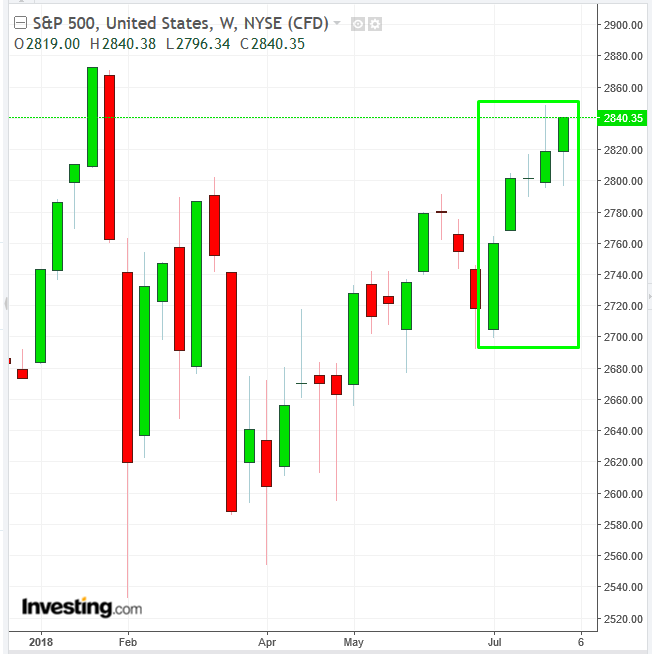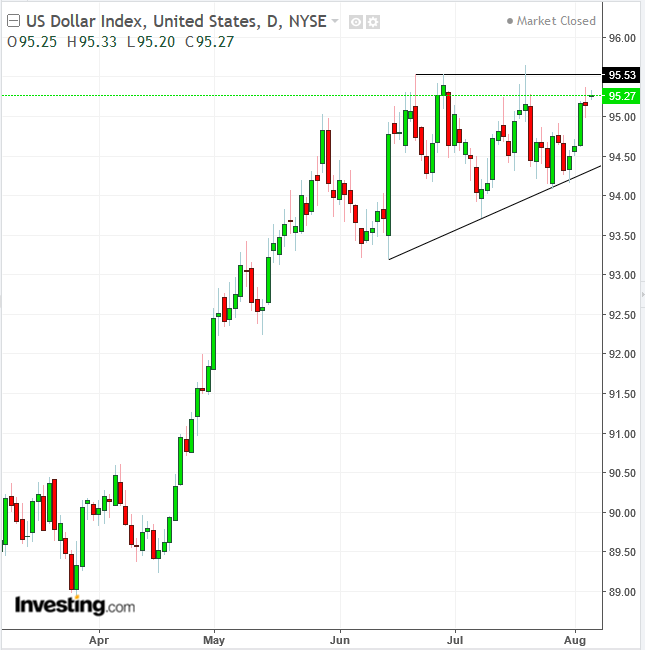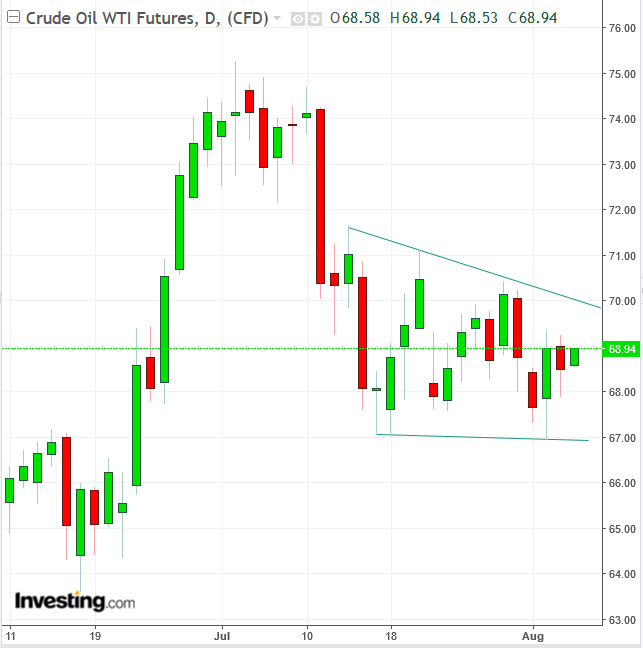-
Carmakers boost European equities, US futures point to rebound from Asian weakness
-
Australian shares confirm outperformance over US-China trade war
-
US stocks cap five weeks of gain on positive economic and earnings data
- Dollar hits 13-month high
-
Earnings season continues with:
-
Disney (NYSE:DIS), due tomorrow after market close, $1.97 EPS forecast, VS $1.58 for the same quarter last year
-
Twenty-First Century Fox (NASDAQ:FOX), due Wednesday after market close, $0.53 EPS forecast, VS $0.36 for the same quarter the previous year.
-
The Reserve Bank of Australia is forecast to hold its cash rates at record lows and confirm its the long-term guidance on Tuesday
-
The Bank of Japan releases minutes from its July 30-31 meeting on Wednesday.
-
The preliminary reading of Japan's second-quarter gross domestic product is out on Thursday. Economists expect a robust rebound from the first-quarter contraction.
-
Analysts expect data due on Friday will show a pick-up in US consumer prices in July
-
The Stoxx Europe 600 increased 0.2 percent.
-
Futures on the S&P 500 climbed 0.1 percent to the highest level in more than a week.
-
The MSCI All-Country World Index fell 0.1 percent.
-
The MSCI Emerging Market Index slipped less than 0.05 percent.
-
The Dollar Index gained 0.15 percent.
-
The euro dropped 0.1 percent to $1.1556, reaching the weakest level in almost six weeks on its fifth straight decline.
-
The British pound slipped 0.1 percent to $1.2993, the weakest level in 11 months.
-
The Japanese yen fell 0.1 percent to 111.33 per dollar.
-
The yield on 10-year Treasuries gained one basis point to 2.95 percent.
-
Germany’s 10-year yield climbed one basis point to 0.42 percent.
-
Britain’s 10-year yield climbed one basis point to 1.329 percent.
-
The Bloomberg Commodity Index fell 0.2 percent.
-
West Texas Intermediate crude climbed 0.4 percent to $68.78 a barrel.
-
LME copper dipped 1.3 percent to $6,124.50 per metric ton, the lowest in more than two weeks.
-
Gold declined 0.2 percent to $1,212.69 an ounce.
Key Events
European shares and futures on the S&P 500, Dow and NASDAQ 100 crawled higher on Monday, as investor mood eased after the latest US-China trade salvos impacted Asian markets.
The pan-European STOXX Europe 600 gained ground, with carmakers and telecommunications companies offsetting losses in bank shares, which were dragged lower by HSBC (NYSE:HSBC)'s disappointing earnings. The outperformance of auto stocks is particularly surprising if we consider that heightened trade tensions are set to hurt car exports in particular.
Earlier, during Asian trade, Japan’s TOPIX dropped 0.56 percent, for a total three-day slide of 2.1 percent.
China’s Shanghai Composite underperformed, plunging 1.29 percent, bringing its combined six-day fall to almost 6 percent.
Hong Kong’s Hang Seng managed to buck the trend, rising 0.52 percent.
South Korea’s KOSPI was flat, retreating less than 0.05 percent.
Australia’s S&P/ASX 200 gained 0.61 percent. The Aussie benchmark hit a 10-year high in July and steadily outperformed its regional peers since the start of the US-China trade spat, despite its dependency on the Chinese market. Several reasons can explain this outperformance:
1) Australian shares have been considered underpriced, as they stand far away from their record levels.
2) The financial sector has enjoyed a reversal after plunging on customer abuse investigations at the country's four largest banks.
3) A weak Aussie dollar favors both equities and tourism.
4) China's efforts to curb pollution led to a shift to higher-quality Iron ore—and Australian's speciality.
Global Financial Affairs

Friday's US session capped a fifth straight weekly gain for both the S&P 500 and the Dow Jones. The performance of the Dow is noteworthy, as the mega-cap companies listed on the index are dependent on exports for continued growth: traders seem to have prioritized actual economic and corporate performance over trade worries.
US payrolls ticked 157,000 higher in July, missing the 190,000 estimate, but the overall jobs report was favorable. The unemployment rate fell one-tenth of a percentage point to 3.9 percent. Average hourly earnings edged 2.7 percent higher year-on-year and June's jobs numbers were revised higher, from 244,000 to 248,000. Average gains for the three-month period were 224,000.
The upbeat US economy and recent corporate earnings beats helped President Donald Trump defend his tariffs hardline and re-instate that the country is winning the trade battle. The question investors must be asking themselves now is whether Trump's renewed rhetoric could undo the country's robust macro and micro fundamentals.
Meanwhile, Beijing said it is prepared to cope with the economic fallout of the trade war. Chinese policymakers stepped in to support the yuan on Friday, helping a rally, after a record string of weekly losses saw the currency close at 7 per dollar. The renminbi later pared some of those gains.

The Dollar Index climbed for the fourth session out of five, to reach 0.15 percent from the June 28, 95.39 close, the highest level in almost 13 months. Technically, the USD is nearing the top of an ascending triangle, bullish with an upside breakout, demonstrating that demand has absorbed all the available supply and is poised to bid prices higher.
The yield on 10-year Treasuries steadied at 2.95 percent.

Oil climbed above $69, even against the headwind of a stronger dollar. Technically, however, its climb is within a descending triangle, bearish with a downside breakout, suggesting supply has absorbed all of the demand and is prepared to go lower.
Up Ahead
Market Moves
Stocks
Currencies
Bonds
Commodities
